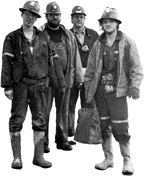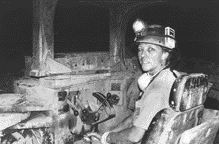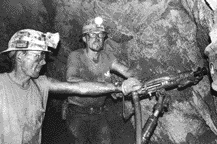
by Jon Christensen
I shall now ask the reader to accompany me in a ramble far below the light of day, to the underground regions of the silver-mines. During our trip through the lower levels of the mines I shall endeavor to explain all that is seen.
--Dan De Quille, The Big Bonanza
I have been delving deeply into the mining history
of Nevada lately. I was curious to compare contemporary
underground gold mines in northern Nevada to the Comstock
silver mines of more than a century ago. So this winter
I arranged a visit to a gold mine on the Carlin Trend
in order to bring Great Basin readers a report on what
it is going on underground in our fair state today.

Nevada is called the Silver State, "but it's really the Gold State," says Michael Brown, vice president of public relations for Barrick Gold Corp. The state produced a record 7 million ounces of gold last year--60 percent of the total produced in the United States comes. The Barrick Goldstrike mine near Elko is the world's single biggest producer of gold.
Brown works in Washington, D.C. But he meets me at the Elko airport as the prop jet from Reno disgorged its load of miners, mining surveyors, mining lawyers, and mining soil samplers.
The blacktop road west to the mines glistens from a light dusting of snow as we drive west to the mine. When I tell Brown that I admire the style of the old-timers such as Dan De Quille, the mining editor of The Territorial Enterprise, and hope to bring some of their verve to my own reporting, he looks at me with alarm on his face.
I assure him that I know the times have changed. Journalists don't have quite the same license to exaggerate that they once had--19th century journalism was the father of contemporary libel laws. I add that I am certainly not fishing for a gift of stock or gold-laced specimens, like De Quille and others of his era often accepted in exchange for hyping a mine.
Brown had worked for the Treasury Department, and was in charge of the Fort Knox files before moving to the Gold Institute and then to Barrick. He's gone from one end of the gold business, gold as a financial instrument, to the other, the mine. Now Barrick, along with much of the rest of the gold mining industry is going underground.
"The trend in Nevada is really underground," says Brown. "The reserves at the surface are being mined. New reserves are at depth. It's much more efficient to access them underground than in an open pit."
Barrick's Meikle mine is the largest underground gold mine in the United States, he said, both in terms of production--it is expected to produce 400,000 ounces a year --and in terms of reserves--an estimated 6.6 million ounces are in the ground, said Brown.
"We're also technologically the industry's leading underground gold mine," he said. "I don't know where they come up with these numbers but they say our air conditioning system could cool 3,000 homes in Las Vegas in the middle of the summer."
The air conditioning is necessary because the rock was saturated with hot water before pumps lowered the ground water table below the mine. The rock walls reach 140 degrees in some parts of the mine. Working conditions are tough.
"Underground miners can pretty well write their own ticket," says Brown. "There is a shortage. They have the highest paid industrial blue collar jobs in the state. Miners make $46,000 a year on average--just about double the service sector's salary levels.--plus they get a whole gold plated benefit program,' including dental, health, 401K, pension, and housing assistance."
We drive through the Tuscarora Mountains, cutting across the middle of the 35 mile long, 5 mile wide Carlin Trend, the mining district at the center of Nevada's current gold boom. "A hundred years ago prospectors suspected gold was here," Brown said, "but it was microscopic. They didn't have the ability to find it. Only modern technology made it feasible. Still exploration uses the journals of prospectors of years ago and it gives them insights and clues."
A gold company has to grow to survive, he said, and "to grow you need to continue to find new reserves and then put them into production.
"The future looks bright," he said.
"The final chapter for Goldstrike has not been written. We'll be mining well into the next century. Every estimate as to how much gold is in the Carlin Trend has been off by tens of millions of ounces."
When we approach the main shaft and hoisting works of the Consolidated Virginia Mining Company we find before us a main building of great size, from which extend several large wings. Upon entering the main building we are at once struck by the peculiar style of dress worn by the men we see grouped or moving about. They all wear gray or blue woolen shirts , caps or narrow brimmed felt hats, and blue cotton or thin woolen overalls. They are all serious looking men, and their faces all seem bleached out to an unnatural and unhealthy whiteness. The whole building is floored as handsomely as though it were a church, and all the floors are scrupulously neat and clean.
--Dan De Quille, The Big Bonanza
Upon arrival at the Meikle mine, we enter the main administration building, which looks much like a huge grey metal garage from the outside. The ground floor is busy with miners and geologists coming and going from their underground appointments.
In an office upstairs, Steve Long, the mine superintendent, acquaints us with emergency equipment and evacuation procedures in case there is an "explosion or fire" in the mine. The big concern is carbon monoxide "which bonds more readily to red blood cells than oxygen," says Long. " You could breathe you just can't get what you need." So all miners and visitors must carry a "self rescuer," which looks like a snorkel mouthpiece attached to a can of Spam. But instead of meat, the can is filled with a heavy mineral called hopcalite, Long explains, which converts carbon monoxide to carbon dioxide, which is normal to breathe. "A by-product of that chemical reaction is heat," he says. "If the carbon monoxide level reached
1 percent the mouthpiece would reach 300 degrees and scorch your mouth, but if you removed it you would die.
"Did I sufficiently scare you yet?" he asks. "All the regulations on mining where written in the blood of people who died. Any questions?"
There being none--I was too rapt with anticipation--he took us downstairs where we dressed in white jump suits and rubber boots and were equipped with a hard hat, headlamp, safety glasses, and self-rescuer. Long shows us where to hang brass tags on a board so that rescuers would know where we were if something should go wrong. "Let's go catch a cage," he says.
We go out into the cold and walk a hundred yards or so to the principal shaft of the mine. Miners stand around in their timeless attire: muddy boots, dirt covered clothes, banged up hats and headlamps. A lot has changed in the mining business. But much of it still looks familiar, even if one has never been so close to a real underground mine. A bell signals the arrival of the cage that will take us underground.
One of the foremen of the mine, the superintendent, or whoever is to be our conductor groups us upon the cage, showing us where we may safely grasp its iron frame for support, and finally we are in position. The engineer is standing with one hand on the lever of his engine, watching our proceedings. Our conductor turns toward him with a wave of the hand. Instantly we feel ourselves dropping into the depth and darkness of the shaft.
--Dan De Quille, The Big Bonanza
The metal cage is like a rickety service elevator in an old apartment building. The rattle increases as we drop. Eight headlamps dart around the cage. After a few long minutes, we stop abruptly, the door opens, and we emerge into a vast dark cavern 1,025 feet below the surface of the earth.
Long rushes out leading us into the dark. Instantly my safety glasses fog up as the warm moist air hits me. It's like walking into a sauna. The lights blur. I stumble, take off my glasses despite the admonitions I'd received about safety, try to wipe them, put them back on, stumble on, nearly fall in a pool of water, then take off the glasses again. Long has turned left in the main tunnel and is striding away at the edge of the darkness. There are no lights except for our headlamps in the pitch black 15-foot square tunnel. Then up ahead light comes from a side drift into which Long has disappeared.
When I catch up, Long introduces me to a gnome-like bearded fellow with a crooked grin. He stands beside a hydraulic drill considering a blue square painted in the rock face which is pockmarked with drill holes. Steam whistles from cracks in the walls.
Gary Alyea is dressed in a tattered black Hank Williams Jr. tank top. He is covered from head to toe with mud and sweat. Alyea's from Montana and has been underground for 14 years. "It gets in your blood," he says. "Anytime you can drift around and do different things it gets in your blood. And the money's good."
By the end of his shift, Alyea will have packed the holes with explosives, which will go off as soon as he and other miners on the day shift make it to the surface after their 11-1/2 hour shift. When the night shift mucks out the hole, the drift he is working on will be extended another 10 feet.
We backtrack to the cavern into which we first emerged, but this time Long heads down the spiral ramp that connects the various levels of the mine. As we go down, I feel the air from the mine's great air conditioning system rushing up and cooling my face. The ventilation is designed such that the cold air is forced down to the bottom of the mine and so it rises as hot air is sucked off the top layers.
Down, down we go. It is like descending a parking ramp to Hell. We pass other souls in the dark who nod or wave or trudge by, their shadows dancing on the wet muddy floor. A small truck approaches. It is designed to fit in the narrow tunnels. Still we have to squeeze against the rock walls to let it pass. The walls are bare rock. No timbers are needed in this mine to keep the tunnels from caving in. "It would have been mined without supports because it's such good strong ground," says Long. Instead all that's needed is a sturdy wire mesh that is bolted to the ceiling and walls to hold loose rocks in place.
On the next level down, Long shows off a spectacular crystal cavern--a whole room of giant pillow shaped formations covered with a thick translucent coating of green glass tinged with ruddy barite. Miners have discovered several of these caverns, which are somewhat of a nuisance to their operation, but this one has been preserved. The crystals sparkle in lights that the miners have carefully placed to impress visitors.
These crystal voids were once filled with hydrothermal fluids, hot water containing crystal forming minerals. The crystals were deposited much in the same way as gold was deposited here, Long says, when the temperature and pressure was just right for the minerals to precipitate out of solution.
Long flags down a loader using his headlamp. "Moving the light side to side means no", he says. "Up and down means back up. Circle means come to me."
 Long introduces the driver, Debbie Ogden. It's not
"so unusual" to see women underground now, not like
"it used to be," she says. Ogden has been working underground
since 1978 in "Colorado, Arizona, wherever there's
mining you go." A single mom with three daughters,
Ogden came to Elko for the "long term employment. I'm
tired of moving around. My kids are in high school.
I want them to graduate."
Long introduces the driver, Debbie Ogden. It's not
"so unusual" to see women underground now, not like
"it used to be," she says. Ogden has been working underground
since 1978 in "Colorado, Arizona, wherever there's
mining you go." A single mom with three daughters,
Ogden came to Elko for the "long term employment. I'm
tired of moving around. My kids are in high school.
I want them to graduate."
"You'll find that miners have typically been all around the West," says Long. "My father was a miner. We moved around a lot. I've been all over the Western states."
Down another level and back in a side tunnel, we come across two geologists filling white fabric bags that look like money bags with dirt and rock. "Any color guys?" Long jokes. We are standing in the heart of the gold bearing ore body. But you can't tell by looking at it. It's just grey rocks dripping with moisture. A few crystals shine in veins on the wall but it's probably fool's gold. The real thing is invisible here.
We may take our stand here, where the miners are digging out the ore, and for a distance of seventy-five feet on each side of us all is ore, while we may gaze upward to nearly that height, to where the twinkling of candles show us miners delving into the same great mass of wealth. On all sides of the pyramidal scaffold of timbers to its very apex, where the candles twinkle like stars in the heavens, we see the miners cutting their way into the precious ore--battering it with sledge-hammers and cutting it to pieces with their picks as though it were but common sandstone.
--Dan De Quille, The Big Bonanza
The hammering of a compressed air drill reverberates down the tunnel. We advance toward the sound and find two miners using a jackleg drill to bolt the metal and wire supports to the walls of a new drift. The jackleg drill is a very traditional piece of mining equipment used all over the world, Long says.
 Tom Huhta is 48 and he's been a miner since he turned
20. His partner, Dale Spring, is 43. He started mining
when he was 18.
Tom Huhta is 48 and he's been a miner since he turned
20. His partner, Dale Spring, is 43. He started mining
when he was 18.
"It's nice and cool now," says Huhta, sweat pouring from his face. "It was like an oven earlier. The air was too far back. But when you start stirring the muck up it gets hot."
"These guys are into a freshly blasted muck pile giving off 140 degree heat," Long explains. " At the end of every shift we turn off the ventilation and move back the ventilation pipes so that they don't get damaged. We blast and then flush the air out for a half hour before the next shift."
I was beginning to form a picture of this underground mining as something like building a parking garage underground. But instead of excavating a hole and then building the garage, here an elevator shaft is first sunk straight into the ground. Then miners get out at the various levels and blast their way into the rock toward where the spiral ramp will be.They then connect up the levels and start extending the floors. When they get to the ore body it works a little different. Starting at the bottom, on the first floor, they clear out a giant parking stall. They do the same thing at the same place two stories above. Then they blow up the floor in between the two levels. The rubble falls into what miners call a muck pile on the first floor. They haul out the pile of ore and fill the void created in the first two floors with a solid cement block. Then they go up to the fourth floor and blow up the third floor. And so on all the way to the top. By doing this in alternating vertical spaces --in stalls one and three, for example, rather than in adjacent spaces--they maintain a solid block of rock on either side as they go up.
We ride the cage back up to the surface with geologist Andre Bourget, who moved here from Val D'Or--the valley of gold--in Quebec. "Now you see a true mine," he says with a French accent. After showering and changing into a red turtleneck, jeans, and loafers, Bourget reports his underground findings on a big marker board at the dispatch center in the main building.
"For the underground workers muck is muck," he says. "That's why we use this board to track the grade of the ore--how much gold it contains--because here on the Carlin Trend you can't see the mineralization." Bourget takes the cap off a marker and writes "ORE" on the white board in bold red capital letters. And like Dan De Quille, I feel I have "seen the elephant," even though I never did see the gold.
Photos by Jon Christenen, Captions:
Underground miners:
Andre Bourget on left,
Steve Long in back
Debbie Ogden:
"Wherever there's mining you go."
Tom Huhta and Dale Spring
1,175 feet down under
Copyright © 1997, Great Basin News Service
Designed by
Sierra Wave Internet Arts.